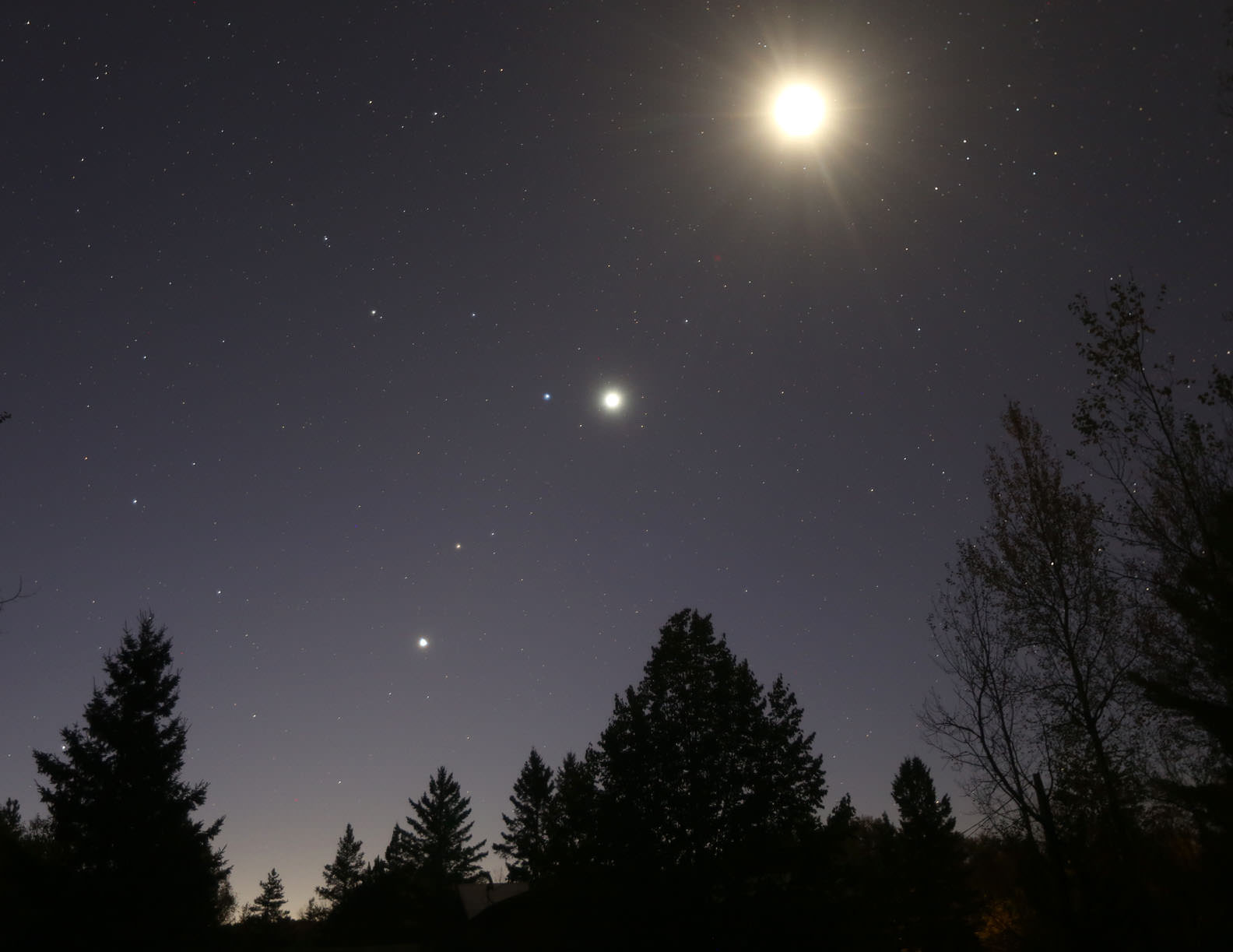Tomorrow morning might be a good time to call for extra celestial traffic control. A slip of a crescent Moon will join a passel of planets in the dawn sky for the first of several exciting conjunctions over the next few days.
[caption id="attachment_122759" align="aligncenter" width="580"]
The scene facing east about 1 1/2 hours before sunrise Thursday morning Oct. 8. Let your eyes delight in the tumble of Moon and planets. Source: Stellarium[/caption]
In the space of three mornings beginning tomorrow, four planets, the Moon and the star Regulus will participate in six separate
. Here's how it'll play out. Time are shown in UT / Greenwich Mean Time and Central Daylight and 1° equals two full moon diameters:
- October 8: Venus 2.5° south of Regulus at 18 UT (1 p.m. CDT)
- October 8: Regulus 3.1° north of the moon at 19 UT (2 p.m. CDT)
- October 8: Venus 0.6° north of the moon at 20 UT (3 p.m. CDT)
- October 9: Mars 3.2° north of the moon at 14 UT (9 a.m. CDT)
- October 9: Jupiter 2.5° north of the moon at 21 UT (4 p.m.)
- October 11: Mercury 0.8° north of the moon 11 UT (6 a.m. CDT)
[caption id="attachment_122749" align="alignright" width="250"]
The crescent Moon will be near Venus all day Thursday for the Americas until it sets in late afternoon. What a great opportunity to catch sight of the planet in the middle of the day. This binocular view depicts their arrangement around noon CDT Oct. 8, when the planet lies less than 2° from the Moon. Source:: Stellarium[/caption]
Since several of the events occur in the middle of the afternoon for skywatchers in the Americas, here's an expanded viewing guide:
- Thursday, October 8: Skywatchers will see Venus pass 2.5° south of Leo's brightest star Regulus with a cool crescent moon a little more than 3° to the west of the brilliant planet. If you live in Japan and the Far East, you'll see a splendidly close conjunction of the moon and Venus at dawn on October 9, when the pair will be separated by a hair more than one moon diameter (0.6°). At nearly the same time, the moon will be in conjunction with Regulus.
Observers in Australia and New Zealand will see the Moon
occult
Venus in a dark sky sky before dawn (or in daylight, depending on exact location) on the 9th. Click
for information, times and a map for the event.
[caption id="attachment_122750" align="aligncenter" width="580"]
Ready to set the alarm again? The following morning, October 9, the moon makes a neat triangle with Jupiter and Mars. Source: Stellarium[/caption]
*
- Friday, October 9
-
An even thinner moon passes about 3° north of Mars in the Americas at dawn and approximately 4° from Jupiter. Watch for the three luminaries to sketch a nifty triangle in the eastern sky 90 minutes to an hour before sunrise. Venus will gaze down at the planetary conclave 10° further west.
[caption id="attachment_122751" align="aligncenter" width="580"]
There's not much of the Moon left by Saturday morning the 11th. The knife-edge crescent will hang less than a degree below the planet Mercury 40 minutes before sunrise. Make sure you find a spot with a good eastern horizon. Source: Stellarium[/caption]
*
- Sunday, October 11
-
Mercury, which has quietly taken up residence again in the dawn sky, hovers 0.8° above a hair-thin moon this morning at 6 a.m. CDT. Best views will be about 45 minutes before sunrise, when the pair rises high enough to clear distant trees. Bring binoculars to help you spot the planet.
[caption id="attachment_122752" align="aligncenter" width="466"]
After a short break, Mars and Jupiter will cozy up 0.4 degree apart just before the start of dawn on October 17 CDT. Venus won't be far away. Source: Stellarium[/caption]
You're thinking, why does this all have to happen in the morning? Thankfully, sunrise occurs around 7 a.m. for many locations, so you can see all these cool happenings in twilight around 6 a.m. — not terribly unreasonable. And now that the
The Martian
has finally hit the movie theaters, what better time to see the planet in the flesh? By pure coincidence, the location of stranded astronaut Mark Watney in the fictional account —
(Mare Acidalium) — will be facing dawn risers across the Americas and Hawaii this week.
[caption id="attachment_122753" align="aligncenter" width="580"]
October wraps up with a tight trio of three planets before dawn. It will be the closest gathering of three planets since May 27, 2013. The next won't happen till January 10, 2021. Source: Stellarium[/caption]
Dare I say this string of continuous conjunctions is only a warm-up for more to come? Earth's revolution around the Sun quickly brings Jupiter higher in the eastern sky, while Mars races eastward as if on a collision course. The following Saturday on October 17, the two will meet in conjunction less than 1/2 degree (one Full Moon width) apart. Very nice!
But it gets even better. On Tuesday morning, October 27, you'll see all
three
planets huddle at dawn. One degree will separate Jupiter and Venus with Mars bringing up the rear several degrees further east. Feast on the view because there won't be a more compact arrangement of three planets again until January 10, 2021.
 Universe Today
Universe Today
